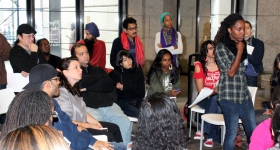Image from KACEDA
Last month, on March 3, 2015, a jury unanimously decided to grant a guilty verdict for mother and domestic violence survivor Nan-Hui until her sentencing date on April 1, 2015. Nan’s story is not uncommon. It is only one of many stories that have come up since the verdict was released. In November 2009, she fled from her physically and emotionally abusive relationship to find herself charged with child abduction and her daughter handed over to her former partner upon her return to the US last year.
While the statistic only reflects reported cases, studies have shown that well over 50% of immigrant women are subject to domestic and sexual violence. Last month, the case of Nan Hui was brought to the nation's attention, which sparked an outpouring of community support for Hui. Yet she remains confined as a result of her attempting to flee her abuser in 2009. Since being jailed for trying to escape her abuser and protect her daughter, Hui has been prevented from seeing her daughter since July 2014.
While media coverage has allowed for the story to reach a wider audience and gain a substantial following, there are many factors that prevent and obstruct justice in this particular case. Non-profit organization, Korean American Coalition to End Domestic Abuse (KACEDA) has been one of the major organizations supporting Nan since her detainment. The organization was founded in 1997 by Korean American women dedicated to ending domestic violence as well as provided much needed to support to immigrant women in need of legal assistance and survivor support. In order to better understand the complexities and systemic issues within the justice and immigration systems, KACEDA shared the following list:
1) A Limited English Proficient (LEP) undocumented person has limited access to information about their rights, due process, family law, immigration law, DV, CA child abduction law, and more.
2) The American legal and immigration systems can be extremely convoluted and challenging to navigate for abuse survivors. They can also perpetuate and facilitate continued abuse or retaliation.
3) Abuse is a repetitive pattern of behaviors in order to maintain power and control over a partner. Abuse includes the use of physical and sexual violence, threats and intimidation, emotional abuse, and economic deprivation.
4) Domestic violence does not necessarily resemble extreme physical torture It is dangerous to believe the notion that abuse must reach lethal levels of violence before it is taken seriously.
5) Tactics of abuse also include manipulation, verbal abuse, veiled threats, physical intimidation, humiliation, pressuring about reproductive choices, etc.
6) Domestic violence is not limited to single “incidents” that can be easily identified and prosecuted. It is an ongoing pattern of behaviors that exists before, during, and after what people traditionally conceive of as domestic violence -- physical assault and explosive violence.
7) Survivors are blamed and judged when they stay in abusive relationships. But in the case of Nan Hui, survivors are also vunerable to being punished and criminalized when they do their best to leave.
The unfortunate reality of Nan Hui's case is the fact testimony and documentation exists that her abuser has, in fact, inflicted violence on Hui. Yet Hui has been faced with criminal charges. Fleeing from an abuser can be a terrifying experience for someone with limited English skills and few resources. Child abduction then becomes the legal charge over domestic violence in many cases. Despite the fact that Hui contacted the police twice for physical harm and harassment, the police did not document her reports. It is imperative to point to the direct correlation between domestic violence and child abuse, which has not been taken into account in his case. The abuser is perceived as capable and fit despite his behavior.
To learn more about the case and the different ways the community could offer its support, I spoke with KACEDA representative Hyejin Shim. She mentioned the primary focus ought to be on the “immediate threats of continued detention and the transferal to an immigration detention facility and deportation.” With direct actions such as packing the courthouse on April 28th, the community can actually help affect change. Shim continued, “undocumented youth organizers, like those of IYC (Immigrant Youth Coalition) and ASPIRE, have successfully stopped deportation proceedings before, and have proven that community pressure and strong media attention can be incredibly powerful tools in halting deportations. It is important for these cases to have visibility and high community interest so that immigration officials are aware that they are being held accountable.”
Women remain one of the most vulnerable demographics to abuses of the legal system as well as domestic and sexual violence. The systems meant to serve and protect have failed in the case of Nan Hui.
Upcoming community action
4/28 SENTENCING HEARING: PACK THE COURTROOM!
Come pack the courtroom with friendly faces on April 28th at 1PM in front of Yolo County Superior Court to show that we continue to #StandWithNanHui.
Follow @StandWithNanHui on Twitter.
Resources to learn more
If you are interested in sending letters of organizational support, please utilize KACEDA's statement.
Information on direct action can be found here.
The social media campaign, #StandwithNanHui.
Press release regarding Hui's case.
You can also send an email to standwithnanhui [at] gmail.com with questions or concerns.
Additional information on API gender based violence can also be found here.










Comments